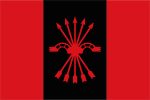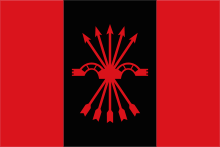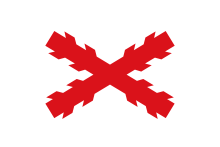| v · Falangistas or Azules (Blue), from the colour of the shirts worn by José Primo de Rivera's fascist organization created during the Second Republic. Camisas viejas (Old shirts) enjoyed the honour of being historical members of the Falange, compared to Camisas nuevas (New shirts), who could be accused of opportunism.
The ideology of the Movimiento Nacional was resumed by the slogan ¡Una, Grande y Libre!, which stood for the indivisibility of the Spanish state and the refusal of any regionalism or decentralization, its imperial character, both past (the defunct Spanish Empire in the Americas, and foreseen in Africa), and its independence towards the purported "Judeo-masonic-Marxist international conspiracy" (a personal obsession of Franco), materialized by the Soviet Union, the European democracies, the United States (until the Pact of Madrid of 1953) or the "exterior enemy" which could threatened the nation at any time, as well as towards the long list of "internal enemies", like "anti-Spanish", "reds", "separatist", "liberals", "Jews" and "Freemasons, among others, coining expressions like "judeomarxistas".
Francoist "families"
Since single-party rule was enforced in Francoist Spain, the only way of pluralism consisted in internal "families" (Familias del Regimen, i.e., different groups of pressure) competing together inside the National Movement. These included the Catholic "family" (which brought the Roman Catholic Church's support and the national Catholicism ideology), the monarchist "family" (or conservative right, composed of many former members of the Spanish Confederation of the Autonomous Right), the traditionalist "family" (issued from Carlism), the military tendency (figures close to Franco himself, including the so-called africanistas) and the Azules themselves or national syndicalists, who controlled the bureaucracy of the so-called Movement: Falange, Sindicato and many others organizations, such as the veterans' national grouping (Agrupación Nacional de Excombatientes), the women's section (Sección Femenina), etc.
Franco held his power by balancing these internal rivalries, cautious not to show any favoritism to any of them nor compromise himself too much to anyone. Thus, all were united by a common interest, the continuation of Franco's defense of traditional Spanish society. The relative plurality of Francoism, inside the official frame of the Movimiento Nacional, has compelled historians such as Juan Linz to classify Francoism as an authoritarian, rather than totalitarian, political system.
Ministers Secretaries General of the Movement
- Raimundo Fernández-Cuesta y Merelo (January 30, 1938 - August 9, 1939) (1st time)
- Agustín Muñoz Grandes (August 9, 1939 - 1940)
- José Luis Arrese Magra (May 19, 1941 - July 20, 1945) (1st time)
- Raimundo Fernández-Cuesta y Merelo (November 5, 1948 - February 15, 1956) (2nd time)
- José Luis Arrese Magra (February 15, 1956 - February 25, 1957) (2nd time)
- José Solís Ruiz (February 25, 1957 - 1969) (1st time)
- Torcuato Fernández-Miranda (1969 - January 1974)
- José Utrera Molina (January 1974 - March 4, 1975)
- Fernando Herrero Tejedor (March 4, 1975 - June 12, 1975)
- José Solís Ruiz (June 1975 - December 12, 1975) (2nd time)
- Adolfo Suárez González (December 12, 1975 - July 6, 1976)
- Ignacio García López (July 7, 1976 - April 13, 1977)
See also
Wikimedia Foundation.
2010.
Look at other dictionaries:
Movimiento Nacional — Para otros usos de este término, véase Movimiento de Liberación Nacional. El yugo y las flechas se incluye en el logotipo del Instituto Nacional de la Vivienda, en la placa identificativa de un edificio de viviendas de protección oficial. Los… … Wikipedia Español Movimiento Nacional — Fahne der Falange Española Die Falange Española ([fa laŋxe], vom Griechischen φἄλαγξ phálanx „Baumstamm“, „Walze“, „Rolle“, „Schlachtreihe“) war in Spanien eine ultranationalistische, faschistische und antikommunistische Bewegung, die im Jahre… … Deutsch Wikipedia Movimiento Nacional — Le Movimiento Nacional (Mouvement national) ou Movimiento était la désignation officielle de l appareil d État de l Espagne franquiste entre 1937 et 1976. Sommaire 1 Movimiento Nacional: définition 1.1 L ideologie du Franquisme ou l idéologie de… … Wikipédia en Français Movimiento Nacional-Socialista de Chile — Bandera del Movimiento Nacional Socialista de Chile hasta 1938, basado en la bandera de la Patria Vieja … Wikipedia Español Movimiento Nacional (Espagne) — Movimiento Nacional Cet article fait partie de la série sur le fascisme. sous série sur la politique Types et formes dérivées Intégralisme Austrofascisme En France En Croatie Garde de fer … Wikipédia en Français Movimiento Nacional Campesino Indígena — Operacional Mediados de los 90 en adelante. Regiones activas Argentina Notas Está integrado por 500.000 familias de más de siete provincias de Argentina. Integrado por los siguientes movimientos campesinos: R … Wikipedia Español Movimiento Nacional Ibañista — Movimiento Nacional Ibañista; organización política de Chile conformada por personalidades afines a Carlos Ibáñez del Campo, ex miembros del Partido Agrario Laborista y otros amigos personales del general, al momento de apoyarlo para la segunda… … Wikipedia Español Movimiento Nacional del Pueblo — (MONAP); fue uno de los varios partidos políticos chilenos que se organizaron en torno a la figura de Carlos Ibáñez del Campo, quien no participó como militante de ninguno de ellos durante la campaña electoral presidencial de 1952, logrando… … Wikipedia Español Movimiento Nacional de Jubilados — de Chile; asociación política chilena de corte social, que intentaba agrupar a todos los jubilados]], pensionados y montepiadas del país, para defender un sistema más justo de jubilación, el cual estaba cada vez menos igualitario. Tenían ciertas… … Wikipedia Español Movimiento Nacional-Demócratas — Se ha sugerido que este artículo o sección sea fusionado con Movimiento Nacional Unido (discusión). Una vez que hayas realizado la fusión de artículos, pide la fusión de historiales aquí … Wikipedia Español
|
 Core tenetsTopicsIdeasWorksListsList of Falangist movementsRelated topics
Core tenetsTopicsIdeasWorksListsList of Falangist movementsRelated topics

